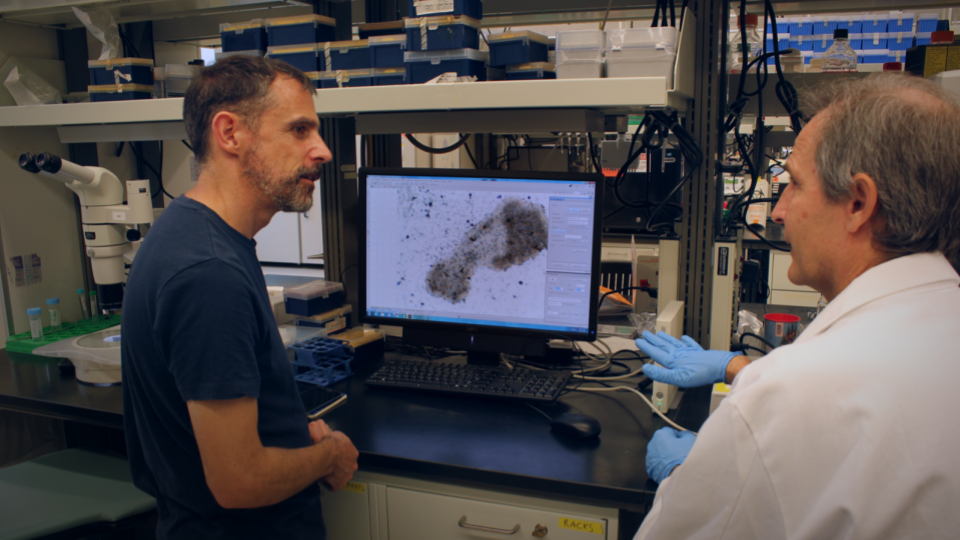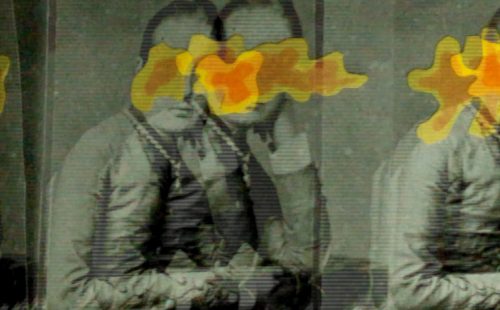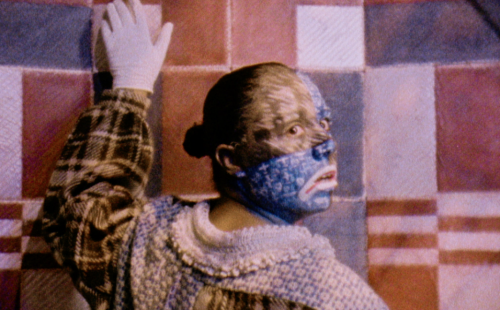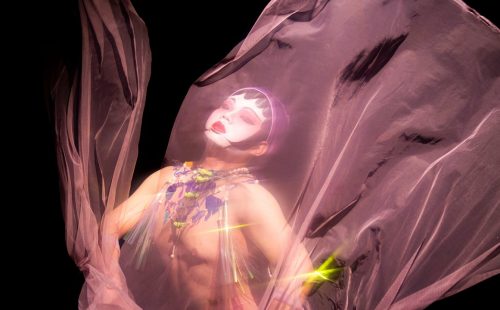
Vicky Isley (VI) and Paul Smith (PS), aka boredomresearch, interviewed by Lucy Sabin (LS).
“You could think of it as cancer in the form of an organism”
LS: As I understand it, this artwork was inspired by the laboratory methods at the Arizona Cancer Evolution Center, specifically their use of ‘model organisms’ for studying adaptations to cancer in other species. Could you describe some of the model organisms and how they inspired you?
VI: One of the organisms the scientists are inspired by is the saguaro cactus. It has these semantic mutations, which are like cancer. You know the cacti you get in Westerns, the stereotypical ones with the arms? When they get big, some of them mutate and develop ‘crests’. They essentially have what looks like a brassica broccoli coming out of their head. The Center actually commissioned a landscape gardener to create a cacti garden outside their laboratories – a garden of cancerous cacti! So, their approach already involved collaborations with artists before we arrived.
PS: For In Search of Chemozoa, we took as inspiration one of the organisms that they were working with [the Placozoa], and kind of created its nemesis by literally programming the cancerous mechanic into its cells. From birth, effectively, the cells of the Chemozoa are dividing and mutating in a way that we could understand as cancerous. You could think of it as a simulation of cancer in the form of an organism. Then we have a whole universe for this organism in terms of its being and how, in its life cycle, it relates closely to the ways that the scientists are thinking about approaching cancer in humans. It’s a way of managing cancer long term so we can live long healthy lives with cancer rather than trying, and failing to cure cancer. So that’s very much the life cycle of this being. It’s trying to regulate that cancerous divergence in terms of the mutations of its cells rather than trying to remove, trying to cure.
VI: Inside the Chemozoa, you’ll see these red bits floating around and that’s to represent the toxic algae that they’re feeding off. And so effectively they’re giving themselves their own chemo dosage. That’s why it’s all about balance because they’re trying to balance how much they’re feeding and how much they don’t. In the Chemozoa film, as they’re feeding, they’ll grow bigger but also, you’ll see this mechanism of apoptosis where the cells basically commit suicide. Then the Chemozoa shrink.
PS: What they’re trying to do is manage the divergent clones. As the cells mutate, they have a population of clones that could potentially… in the case of a human tumour the risk is that they could include mutations that are quite aggressive. This could lead to cancer developing in a way that could be fatal for humans. A lot of the research just focuses on how you manage complexity in terms of that diversity and maintaining balance.
LS: You modelled the Chemozoa on a real marine microorganism, the enigmatic Placozoa, one of the simplest known animals on Earth that was first discovered in the late 1800s and remained forgotten by biologists for the next century. What is it about the cancer research on Placozoa that caught your attention?

VI: When the Center invited us to their labs, we became part of that team. We were bridging the two labs: there’s a psychology lab, which investigates cancer in terms of cooperation and conflict, then there’s the evolutionary biology lab. The dialogue between the two labs is quite fluid. One of the researchers, Dr. Angelo Fortunato, was also working across both labs. We were drawn to Angelo, who was investigating the Placozoa, because he’s so creative. With his tanks, he does these ‘plotter’ drawings where he sticks bits of acetate to the glass to plot the organism’s movement by hand. The drawings are phenomenal and he’s so immersed in that world.
VI: Angelo blends cancer research with evolutionary biology. It was the two-prong approach that really pulled us into his research on the Placozoa. He was working with concepts of human health while remaining profoundly thoughtful of environmental health and the fact that the two cannot be separated. That way of thinking about those two things is very in tune with how we’re approaching our work not just to think about our own survival in terms of keeping the insides of our bodies going but that we are also ourselves bodies that impact on their environment.
Life is a restless balance
LS: That holistic approach to health seems encapsulated in the title of the exhibition where you first showed this work, ‘Restless Balance’ (Arizona State University, 2020-21).
PS: Yes, the way that we’re showing the work in Arizona in connection with several other works, all under the umbrella of the idea of restless balance or searching for some sense of stability but recognising change and the awkwardness that that creates. When we first wrote the descriptive of the exhibition, there was a sense of it sort of forewarning the [Covid-19] situation that we’re currently living through.
VI: So restless balance is not only present in the cells of organisms, but also in our thinking about cooperation and conflict in environments as well. That’s why In Search of Chemozoa foregrounds the environmental setting, because we wanted to think about it not only from the organism’s perspective but from a wider perspective. One thing that Angelo [Fortunato] noticed, when he was trying to create this environment for the Placozoa to live in the lab, was that these tiny things would eat everything! And he was thinking, “Wow, this is something that no one’s really looked at before. It’s tiny and it’s hard to see in the world yet it must be having a big effect. This must be one of the architects of the environment in which it lives”.
LS: Of course, a new model organism can never be an abstraction; it must be considered as an integral part of the environment in which it lives and the conditions it has evolved through. The documentary that you produced to accompany In Search of Chemozoa demonstrates how the scientists did some guesswork in optimising the conditions for the Placozoa, setting up saltwater tanks with special aeration systems and even importing rocks from Egypt that contain the Goldilocks combinations of minerals and microbes (boredomresearch 2020). How does this attentiveness to simulating natural conditions in the lab translate into the setting you designed for In Search of Chemozoa? Rocks certainly seem an essential presence.

VI: When we were doing recces for sites for the environment footage, it was important for us to have that ruggedness with lots of barnacles and holes in the rocks made by boring clams. We liked the idea that the Chemozoa hang out in crevices. The Chemozoa rock that you see in the film exists. It’s quite polished now, because we’ve handled it quite a bit. We used photogrammetry to capture its form in three dimensions.
PS: A potential problem arose with the scaling of the rocks in relation to the Chemozoa. We wanted to create something that had screen presence but a maximum cell count of about a thousand cells, so the cells had to be big!
VI: But when we spoke to the scientists about scale, they loved it. They said it would be great if you could just go out with a snorkel to see the Placozoa. Scale makes it difficult to study these organisms in their natural environment. As you say, they try to recreate natural conditions as much as possible, but it’s not the same as observing the organism in its habitat.
The language of the documentary
LS: Certainly, the artistic license you take with scaling up the Chemozoa’s cells allows us to see microorganisms as part of a broader environmental context. That is where your use of both location shooting for scenes above water and computer simulation for the underwater world comes into play. How did you develop this practice of compositing live action with cinematic use of a game engine?
PS: We’re interested in the language of documentary as a familiar language that provides a low resistance way of accessing ideas that are quite hard for a lot of people to really engage with. With a lot of our work, we think broadly about the audiences that we want to engage with. So, we became interested in the language of documentary filmmaking, and there are lots of conventions to follow, such as the establishing shot, where you establish an idea of a location and then you have a journey that takes you from an idea of a place to a particular kind of situation in that place. And it’s in a situation where we can experience a creature and have an introduction really. So, the use of landscape made itself necessary from that perspective in terms of thinking about how we create this presentation and narrative in a way that was accessible yet provided a way we can engage with the science but on our terms rather than how, you know, the scientists were engaging with that subject. So, when scripting the voice-over, which was based on interviews with scientists, we tried not to be too clinical and keep the narrative more poetic, open to interpretation.

VI: I think the journey was an important part of the project as well. Every camera angle transports you further in this search. We pan around a rock before we see the Chemozoa, for example. And we even experienced that searching quality when we were working on the project. The computer-generated part was built within a game engine, which the camera moves through, almost like a first-person shooter or first-person perspective anyway with key controls to navigate that space, moving the camera in a filmic way. We spawn the Chemozoa, in that program, selecting how many cells they’re going to have, and then wait for them to do their thing. The environment was set up with certain shots in mind, such as panning around a rock to see the Chemozoa. Sometimes they would disappear from the visible window, though. So, there were weird moments where we felt as though we were out in nature, trying to document these beings. We experienced this chaos even more with previous works, which used very much fixed windows. It’s only recently that we’ve started to do more camerawork where you’re taken on a journey through that world.
Scientific modelling and imagined worlds
LS: How much of your work is about creating worlds? And I guess I mean worlds within a permanently polluted world.
PS: I feel that they’re all worlds created in a fictional universe. I think that’s how we understand scientific models as well. That the scientific models are in themselves fictions. They’re ways of thinking about a world. And the more and more we immersed ourselves in the worlds of scientists, we got deep into – you know – the processes, and the purposes and with the models that the scientists were creating, we found it increasingly hard to disentangle and to have that clear separation anymore. More and more we felt that the artists – sorry the scientists – the scientists, the scientists, the science-artists were almost… their ability was a creative one, but they were in the business of science. So, they must exploit that creativity in a very particular way. But funnily enough, what they’re doing is they’re creating models, they’re creating their own fictional universes where they can explore and think about the world that they find themselves in and that is a world that has its own problems. And for a lot of these problems, we’re the authors.
LS: Yes, and your last point could be interpreted in two ways. On the one hand, ‘we’ (read: certain human societies) are the authors of environmental disruption writ large. On the other, we are also the authors of any flaws or assumptions embedded in the knowledge-making processes designed for defining and studying those problems. To what extent were you influenced, especially during your residency at the Arizona Cancer Evolution Center, by scientific processes for visualizing, simulating and conceptualizing problems? I imagine it was important to recognize the limitations as well as the strengths of the scientific research you were engaging with, to create a space for artistic inquiry that opens new discussions.

PS: One of our older projects, Afterglow (2016), an experimental film about malaria transmission, was one of our first experiences of negotiating that space with the scientists and trying to understand the models that the scientists were creating, why they were creating them, and how they were useful. How is this useful? How does it relate to an idea of truth? And what does truth mean in a scientific context? Is that the same as truth in an artistic context? We wanted to build a model that was robust in the same way their scientific model was robust but offered us something different from the science. Not, for example, extrapolating something that we could then use as an intervention, but if we’re not doing something useful from the point of view of intervening, then what are we doing? So, we were questioning, what are the limitations of a scientific model? What can’t they do? Certainly in those epidemiological models that we were interested in within the limited range that we experienced them, they were all based on creating very reduced, eloquent expressions that avoided the messy entanglement that would make them scientifically useless. Because as soon as the data passes a few levels of complexity, you can’t interpret it, you can’t make a meaningful scientific claim, you can’t say anything with any kind of certainty, or you can’t show the difference between two scenarios. We wanted to capture the truth of the visual complexity of a disease like malaria as it would exist in a landscape if we were able to see that.
VI: That’s why the spatial element is so important in that work. And it’s from then on that we’ve been working more spatially. Space can be difficult to convey in science models, as Paul was explaining. Scientists often need to streamline data, so a lot of complexity gets thrown out of the window. But we often look for the mess. When we’re in residence, we do what I’ve started to refer to as ‘lurking’. I’ve said this to a couple of people: “Can we just lurk in your lab for a bit?”. Because, otherwise people formalize it.
PS: One of the labs that we were working with for In Search of Chemozoa did a lot of abstract simulations. In a sense, the simulation that we mapped onto the body of the Chemozoa could be unwrapped onto a plane and simplified to look similar in nature to the simulations that the scientists were using as part of their research – to the untrained eye anyway! But then the scientists would map these simulations back onto the world. Scientists go out with their tools, they look at the world and capture something, call it data if you like, they deal with that in a particular way, and it affects the way they think about and understand things. The whole idea being that the model then becomes useful, that you go and apply it back to the world, you can work out how to control or calibrate something that you haven’t controlled or calibrated before. In art, the process kind of gets mapped back to the world in that other people experience the artwork and they take away something that maybe has changed their own experience of the world. But everyone has a unique impression of the work.
I think that’s the key distinction: the language of science is very precise. If you take all the words in the dictionary, the ones that have a single meaning tend to be the scientific ones. Whereas the ones that have more value in an arts context often mean ten different things and are vague, open to interpretation. It’s that kind of difference between science and art, that science must be shared whilst remaining the same and art is something that is offered freely. We’ve made it on our terms, but you can take it on yours.
Emergence and empathy
LS: You’ve talked about the emergent properties of this world. You input variables into the code such as cell count but ultimately the (eco)system that emerges becomes so complex that the Chemozoa behave in ways you might not have anticipated. In a sense, this process mirrors any creative process, which might have a clear starting point to begin with but then intuition take over. Could you say a little more about the role of empathy in your work? The etymology of empathy is ‘feeling into’ if that helps.
PS: If you’re creating an artistic expression of something, you must feel something. So, it’s important that we find the scientists who allow us to understand how they feel about their scientific research. What we’re trying to do is translate the feeling more than the science. We don’t see ourselves as science communicators.
VI: We tend to refer to our work as ‘expressions’ because representation or data visualisation is not our goal. I hope that the scientists we work with see how we’ve emotionally engaged with the subject and how the work carries their emotions as well. We want it to be poetic, to create something beautiful.
PS: There’s also a lot of melancholy in the works we create. We’re always looking to the beauty of the system, but the melancholy comes from somewhere.
VI: I think it’s because we see the fragility in the systems as well. We even experience that through coding the systems, as we said before. You experience fragility when something can easily collapse or become noise. So, when we’re programming something, you see that emergent behaviour and then you kind of experience loss in a way. So that loss comes through, very often it will come through in the sound of our work. When we get to working on the sound, we often bring a very melancholy tone.
PS: The sound comes at the end. We give the work the sound that sounds right for the work and by that time, it’s maybe our experiences of creating the work… we’ve lost control… we’re not really steering it, it’s just kind of happening, I think by that point.
LS: The sound seems like a fitting point to end on then! The voice-over harks back to the language of the documentary, yet without the master narrative one might associate with that genre. What were your intentions with the narration?
BOREDOMRESEARCH [via email]: The narration was a way of bringing in all the different angles from the two different labs we collaborated with at Biodesign – both Carlo Maley’s Cancer and Evolution Lab and Athena Aktipis’s Cooperation and Conflict Lab. Primarily, the script narrates the struggle of the small, multi-celled organisms affecting their own chemotherapeutic treatment by feeding on toxic algae but also how they help balance their own environment. The script addresses the importance of health as a holistic part of a wider philosophical awareness of the interrelatedness and symbiosis that is not just confined to looking inside an organism’s body but also how it is subject to the health of the environment outside the body and the value that flows in both directions, i.e., using nature as a point of inspiration in a biomedical context and biomedical insight into health to better understand our connection with nature outside the body.
We endeavoured to exclude scientific language but instead adopt a suggestive poetic voice to capture some of the rich emotional value that both underlies and motivates the research. Research that informed the narration included text on harmful algae blooms, social feeding behaviour of Placozoa (the organism that inspired the Chemozoa) and cancer cell dynamics.
The script was written to be cyclical so the end flows into the start, so that the audience can start viewing the piece at any point.
We wanted the piece to be performed with weariness and pausing for reflection, to be performed with natural speech, for the narrator to seem wise but without any sense of superiority, to have a touch of melancholy and fragility, at times overcome by a fascination and subtle joy with the curious nature of the world.
—
To watch In Search of Chemozoa online, click here.
About the artists
boredomresearch is a collaboration between British artists Vicky Isley and Paul Smith, internationally renowned for exploring an understanding of the natural world through the medium of computational technologies. Becoming intimately aware of the vulnerability of complex systems, including those which support human life on earth, they present a daring new vision for technological innovation, centered on reuniting the presently splintered domains of art, science and society.
Their work considers our strategies for coping in a world increasingly destabilised by human activity. Collaborating with world leading scientists the artists are challenging a broader concern over a tendency towards increasingly complex solutions to answer the dilemma of environmental crisis.


![]()






